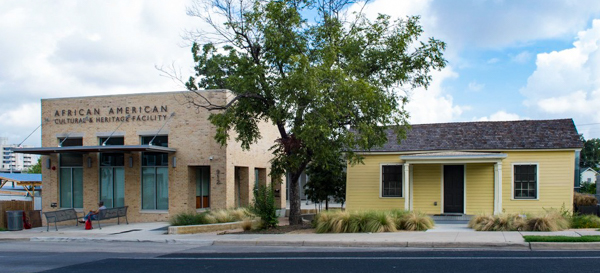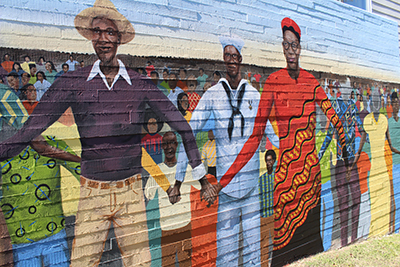The City of Austin Economic Development Department’s African American Cultural and Heritage Facility (AACHF) plays an integral role in the City of Austin’s long-term commitment to protecting and enhancing the quality of life for African Americans.
African American Cultural and Heritage Facility Timeline
2005 |
In early 2005, the African American Quality of Life Report is the result of work between the City, community leaders, neighborhoods and business owners in Austin. The report revealed African American residents continued to experience a strikingly lower quality of life from other Austin residents. On May 26, 2005, Group Solutions (a third party consulting firm hired by the City of Austin), presented 20 recommendations to the Austin City Council and community leaders for review. The recommendations resulted from a series of forums to improve the African American quality of life. On October 27, 2005, City staff worked with community leaders and provided a public presentation to the Austin City Council, which addressed six categories: Arts, Culture & Entertainment, Business & Economic Development, Employment & Education, Health, Neighborhood Sustainability, and Police & Safety. The six categories identified 56 initiatives to be implemented by the African American Quality of Life Committee and included a two-year timeline, which began in January 2006. |
|---|---|
2006 |
In November, Austin residents voted on the 7 General Obligation Bonds. Proposition 4 - $31.5 million tax supported General Obligation Bonds and Notes for constructing, renovating, improving, and equipping community and cultural facilities including, without limitation, the Zachary Scott Theater, an African American Cultural and Heritage Facility, an Asian American Resource Center, the Austin Film Studios, the Mexican American Cultural Center, a Mexic-Arte Art Museum, and acquiring land and interests in land and property necessary to do so; and the levy of a tax sufficient to pay for the bonds and notes. |
2007 |
On December 13, 2007, Council approved a resolution to create the City of Austin’s first African American Cultural Heritage District. African American landmarks include black-owned businesses, churches, the George Washington Carver Museum and Cultural Center, Huston-Tillotson University, the African American Cultural and Heritage Facility and more. |
2008 |
In April, the African American Quality of Life Final Report was published summarizing highlights of the 56 initiatives set forth by the implementation teams of the African American Quality of Life Committee during the two-year period of January 2006 to January 2008. |
2009 |
In March, construction of the African American Cultural and Heritage Facility began which included renovations to the historical Dedrick-Hamilton House. This $1.5 million bond project paved the way for a new anchor facility that serves three critical functions: 1) a small African American Visitors Bureau under the management of the Capital City African American Chamber of Commerce (now known as the Greater Austin Black Chamber of Commerce); 2) the main office of ProArts Collective, the primary producer of African American theater and arts festivals; and 3) African American Technical Resource Center. The Dedrick-Hamilton House was owned by Thomas Dedrick, one of the first freed slaves in Travis County. The home was built circa 1880 in one of the earliest African American communities in East Austin. The fully restored historic house now serves as an African American Visitors Center. The Dedrick-Hamilton House Visitors Center is the centerpiece of the African American Cultural and Heritage Facility and is framed by the complimentary modern structure. |
2010 |
In November, the City of Austin Economic Development Department submitted a Request for Proposals for professional artists to develop a contemporary art piece to honor the cultural heritage of the African American community in Austin. |
2011 |
In February, the City of Austin Economic Development Department Art in Public Places Panel and the Arts Commission approved Reginald C. Adams to create the commissioned artwork. |
2012 |
Reflections by Reginald C. Adams was created and installed. The Economic Development Department Cultural Arts Division organized two mosaic workshops at which members of the public, including students from Kealing Middle School, were able to work on a portion of the mural. Reflections is a tile mosaic mural that captures important people, places, and events in Austin’s African American community. Read the Reflections portrait guide for more information about the individuals and elements featured in the mural. |
2013 |
On March 1, 2013, the African American Cultural and Heritage Facility had a grand opening celebration including a ceremony honoring individuals featured in Reflections by Reginald C. Adams. |
2015 |
On March 1, 2015, The African American Cultural and Heritage Facility opened to the public, adding to the area’s cultural significance by offering arts, business, cultural and entertainment programming. |
2017 |
In November, Portraits of Our History by Ryan Runcie was installed on the east wall of the African American Cultural and Heritage Facility. "This mural is symbol of hope. It is a sign post that good will always overcome evil. A reminder that when we stand as one, anything is possible. For many years, peoples of the African diaspora have challenged and protested their oppressed livelihood to make a more equal and equitable life for themselves and their future relatives to enjoy. Even though we are all needed to make change, their are always leaders, organizers, and social catalysts that must step forward against the inequality and violence their communities have experienced. Depicted in this mural (from left to right) are Deitrick Hamilton, Johnny Holmes, Doris Miller, Dorothy Turner, Gary Clark Jr, Mikaela Ulmer, and Charles Overton. These great men and woman represent the strength and diversity Austin has to overcome great tragedy in pursuit of a peaceful happiness." - Ryan Runcie |




